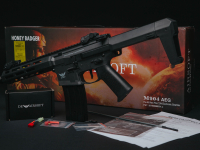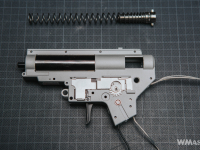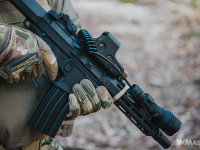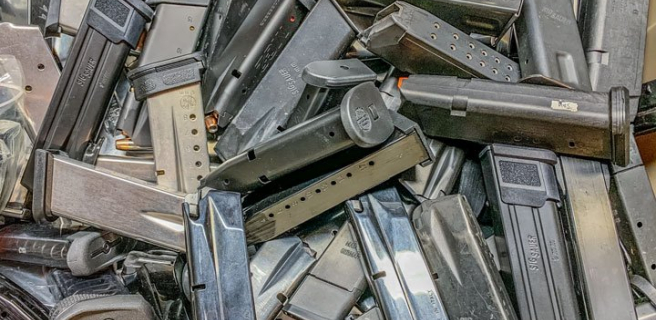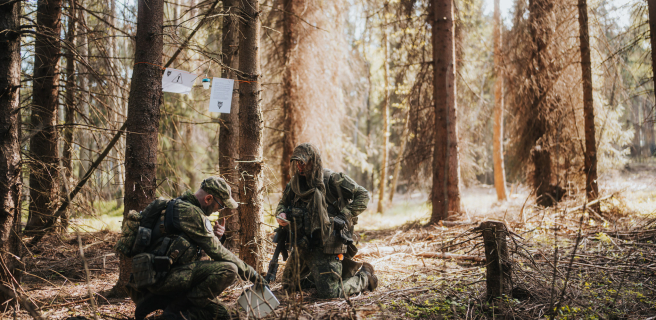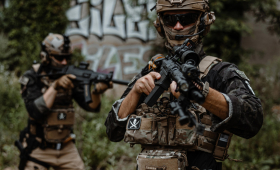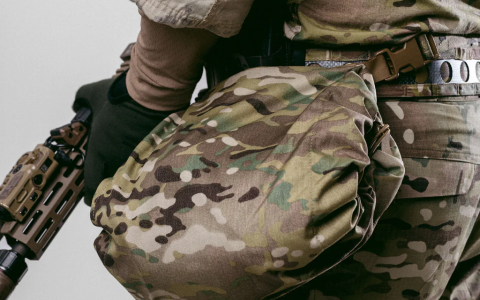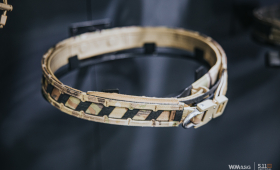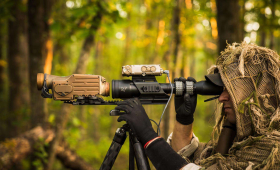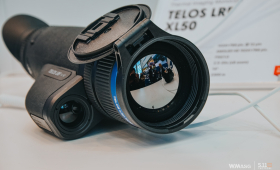In the spring of this year, Double Eagle has introduced to the market a fairly large family of new AR-15 carbine replicas, the common feature of which is the driving mechanism with the Falcon electronic control system. Currently, the series consists of 4 groups of models, which give us a total of 18 different variants to choose from. Some of them are available in 3 different colors, which further increases the number of available versions to a total of 31, which is impressive. The aforementioned groups bear the M90X designations and additional proper names. Within each group, individual replicas are marked with an additional letter (e.g. M904G).

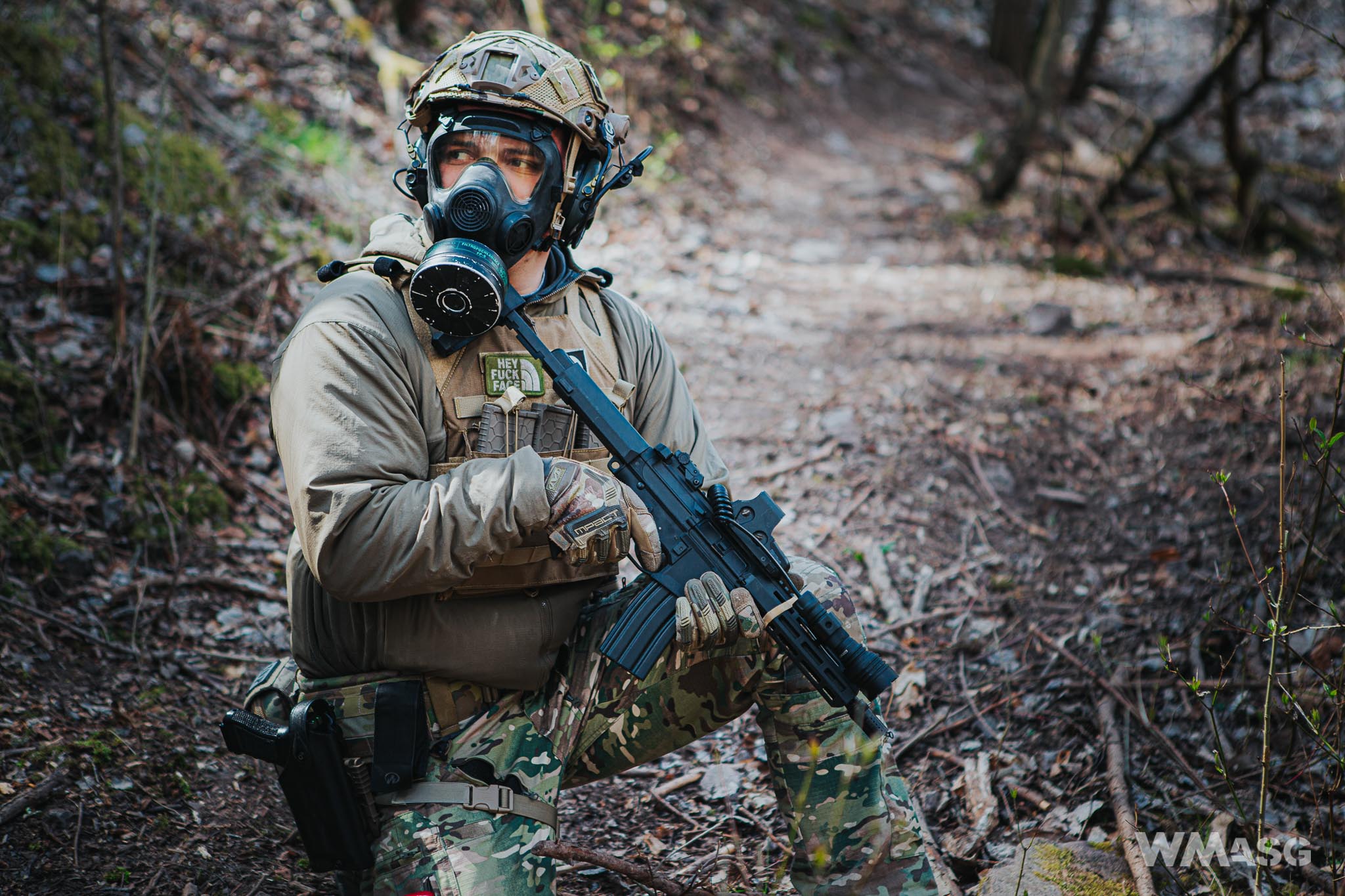
The first group is the M904 Honey Badger. This is the cheapest group of replicas with receivers made of reinforced nylon and this is what we have on the table right now. The featured M904G is absolutely the cheapest of the cheapest - here even the handguard is made of nylon - the other 904 have aluminum handguards.

Replicas from the other groups are made entirely of metal, with receivers are made of ZnAl and the M-LOK standard handguards made of anodized aluminum finished using numerically controlled machines. The M908 Mk16 URGI group uses carefully crafted handguards that resemble GEISSELE product - the Super Modular Rail (from the USASOC URG-I program) in 9.3 and 13.5 inches versions. It is worth noting that despite the material differences from the outside, the replicas are identical internally as they are all driven by the same mechanism.
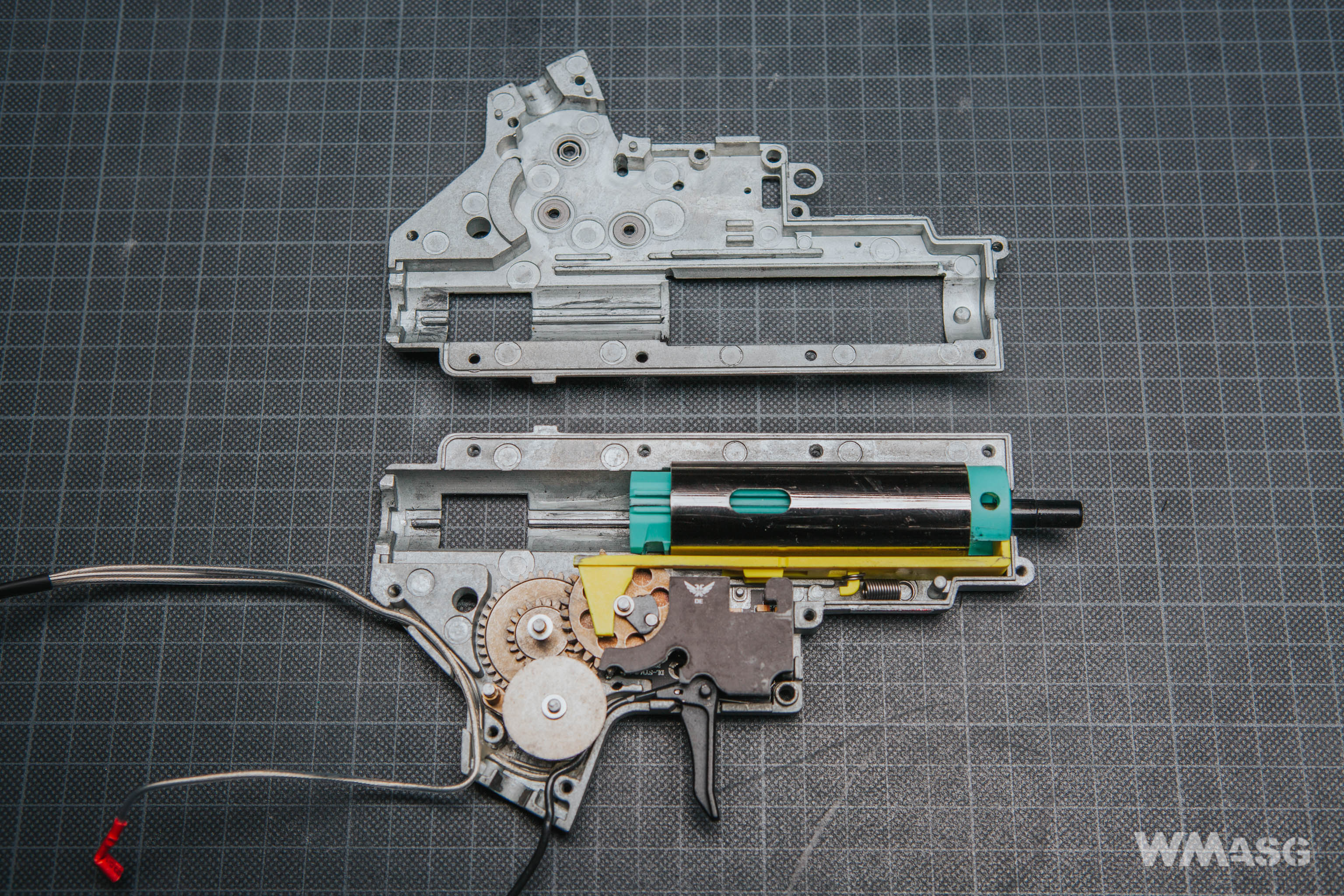
The Falcon control system mentioned above, which is present in all M90X replicas and is the first Double Eagle proprietary solution. The system offers the possibility of programming 3 parameters:
- BURST fire instead of FULL-AUTO mode, with the ability to set the number of shots in a burst from 1 to 5 (setting 1 shot results in the replica shooting with a single fire in both positions of the safety/selector switch);
- a 3-step trigger pull adjustment;
- a two-shot setting in SEMI mode (one shot is fired when the trigger is pulled and the other then the trigger is released).
In addition, Falcon acts as an advanced fuse. We will talk more about the module design and programming methods later in the text.
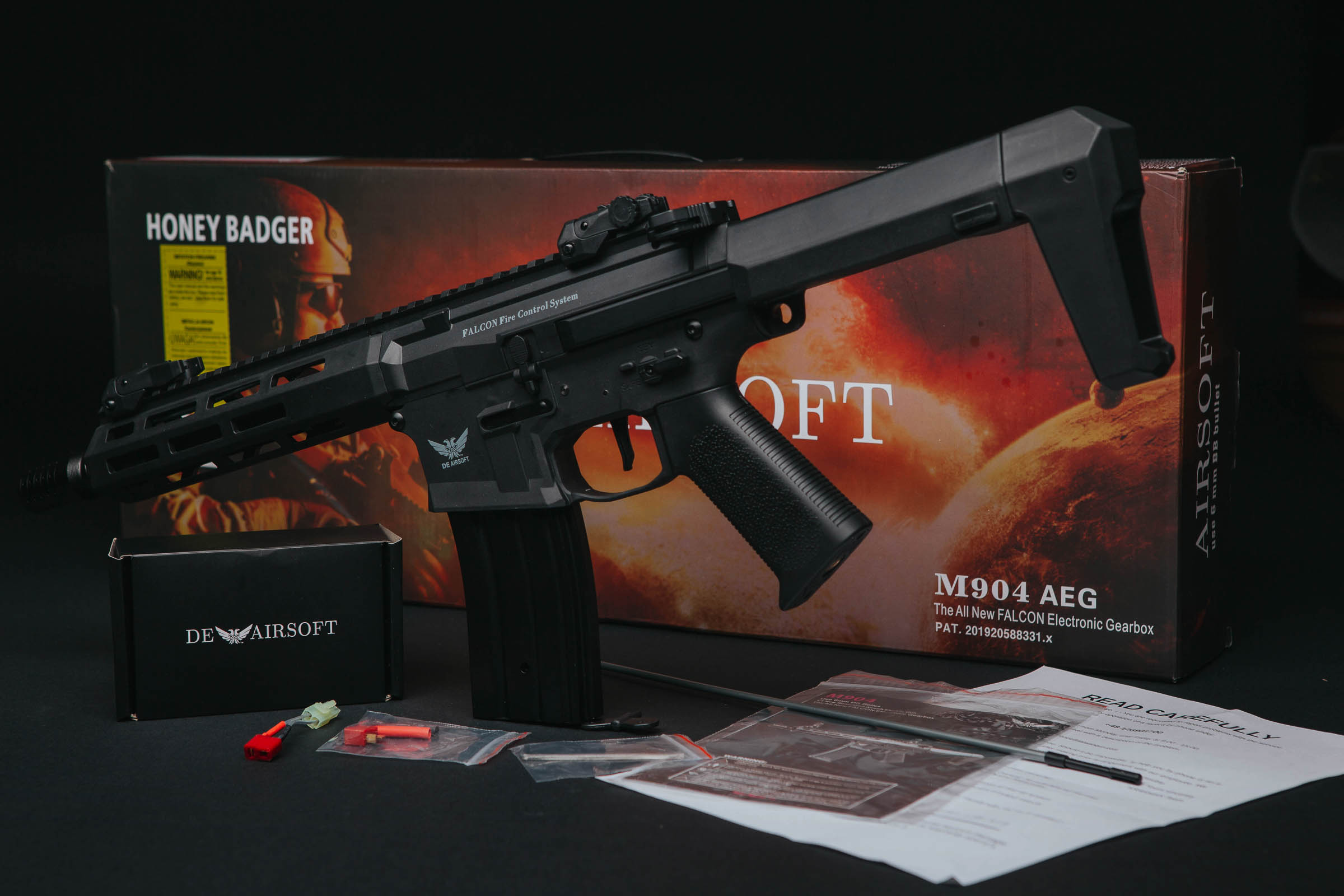
The replica comes with:
- a metal hi-cap magazine (standard design);
- replica and Falcon programming manuals;
- a mini Tamiya/DEANS adapter;
- an additional DEANS female plug and 2 pieces of heat shrink tubes;
- an Allen key for removing sights;
- a key for winding the magazine
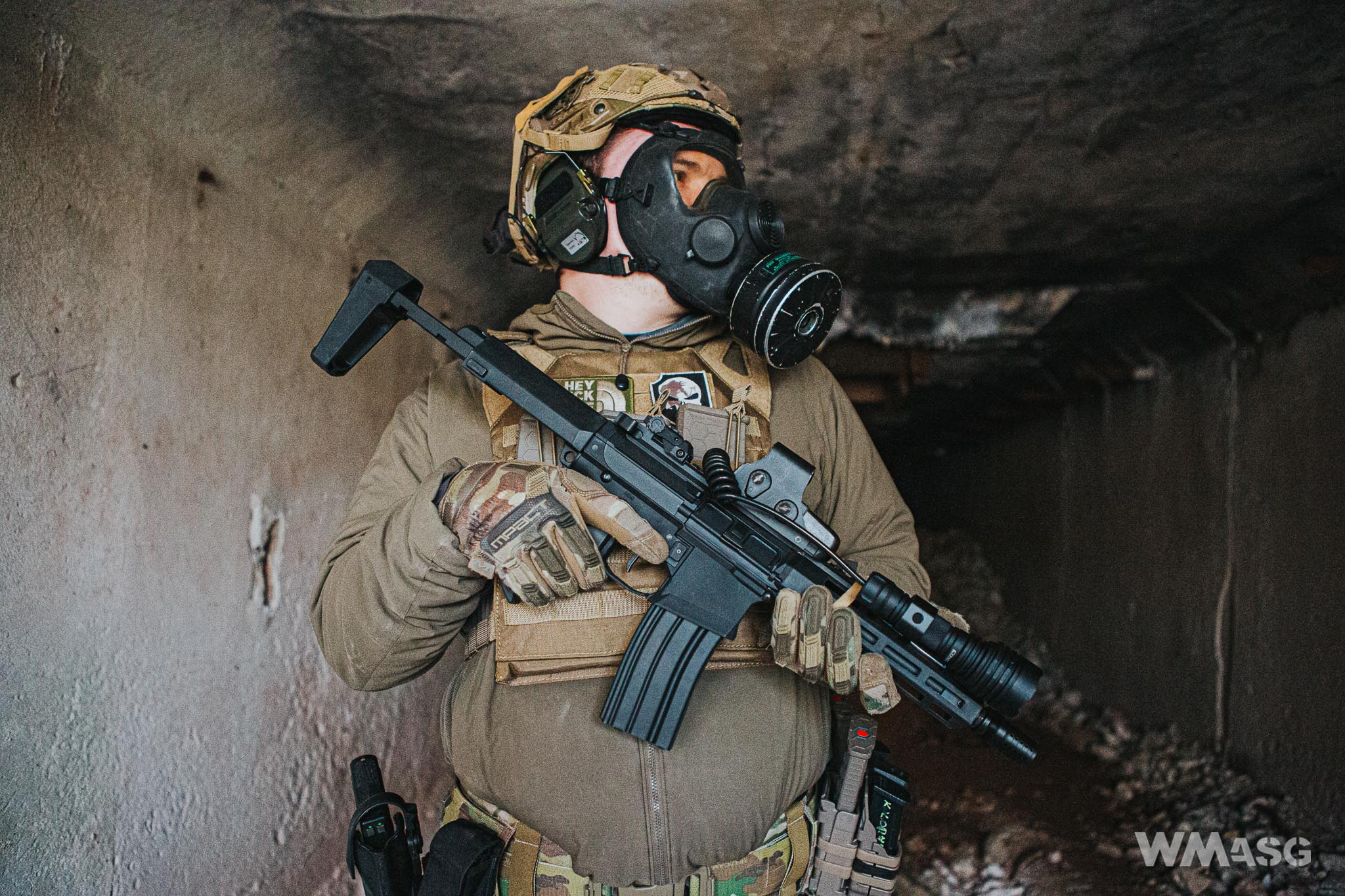
Basic technical parameters of the M904G Honey Badger
- overall length (collapsed/extended stock): 610/710 mm;
- inner barrel length: 215 mm;
- weight (without the magazine and the battery): 1935 g;
- quick spring change system;
- declared muzzle velocity: 370 fps.
Visually, the replica looks good although, of course, you can see at first glance that it is made of nylon, not metal. Although it does not look shoddy as the material is matte. It is not slippery to the touch and through the magnifying glass you can see a fine texture of the surface. When trying to aim the replica immediately after taking it out from the box, we have noticed two things. First of all, the weight. The replica without the magazine and the battery weighs less than 2 kilograms. This is a great result as you can aim it with one hand almost like a pistol. The second thing, certainly a more important one is the stiffness of the replica. We expected that the replica will be somewhat "flexible" as many of the available plastic replicas have this drawback. The Honey Badger doesn't have it! Why? Because of an extremely sensibly designed handguard and the way it is connected to the upper receiver. What is so special here? None of the solutions used is revolutionary, but when combined, they provide the structure with similar stiffness as all-metal replicas.
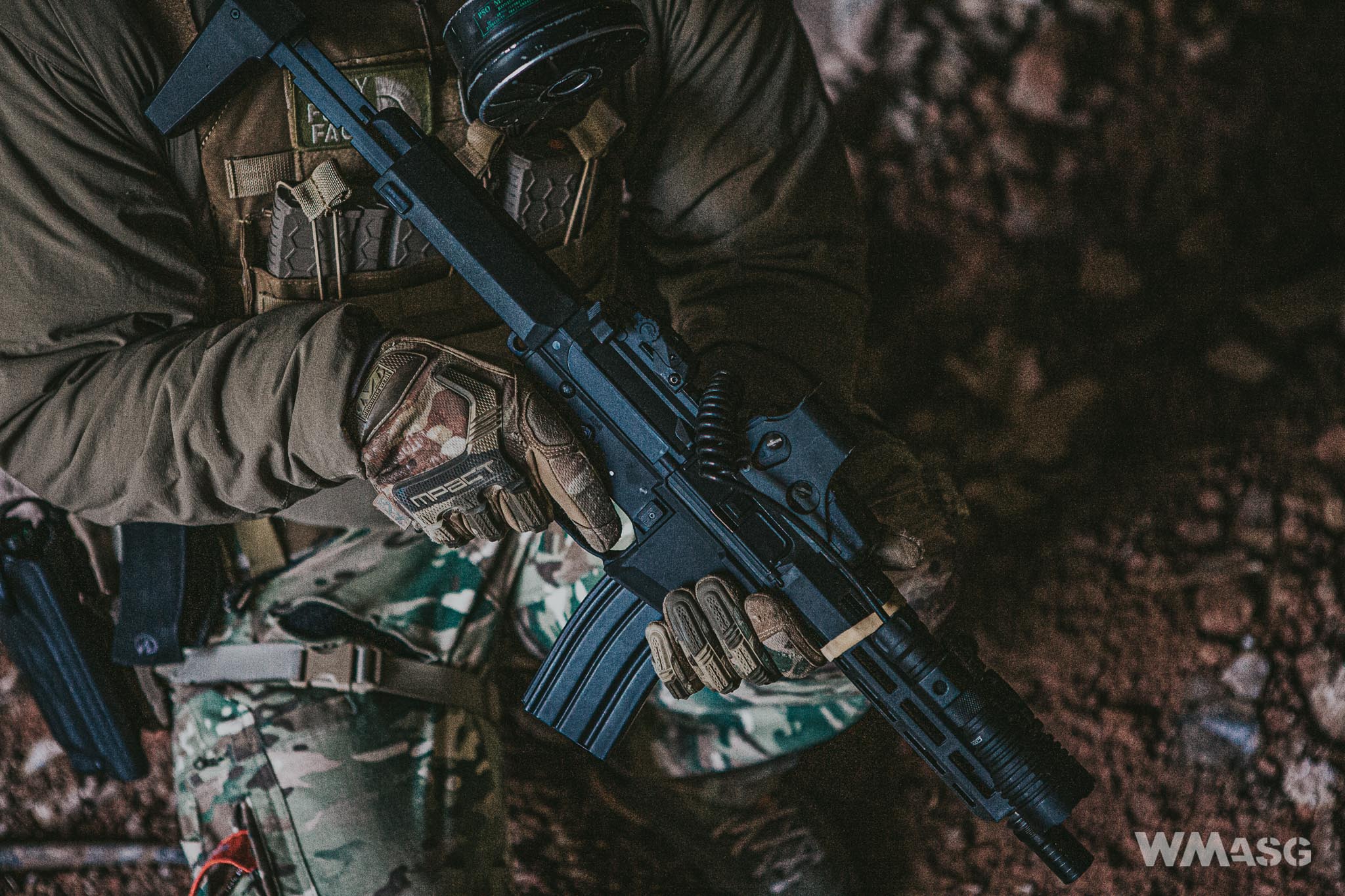

The first thing is the stabilizing pin. A hole is made in the upper receiver, just below the upper Picatinny rail, into which a stabilizing pin placed in the rear part of the handguard is inserted. Thanks to it, both sections of the top rail (on the upper receiver and on the handguard) match perfectly. In addition, the pin is one of the parts that prevents the handguard from rotating around the barrel.
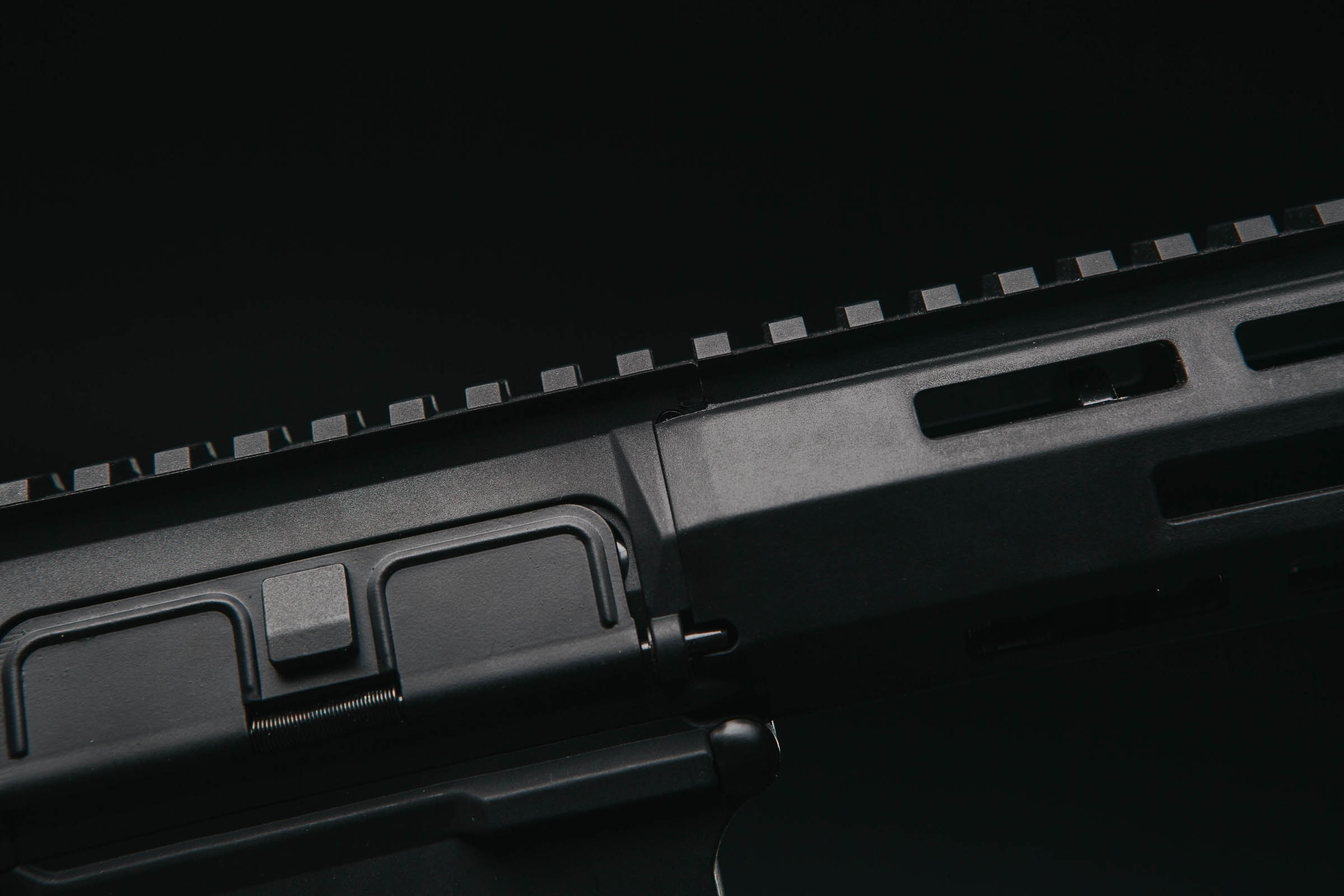
The second thing is the protruding side arts of the handguard, which cover the upper receiver. Their size is such that they slide over the receiver very well, without slack. This is the second element that does not allow rotation and clatter of the handguard.
The third thing is a clever coupling with a Roman screw, which, leaning against the collar of the barrel mounting ring, presses the handguard to the upper receiver. The effect? The replicas is really stiff. And by the way, multitool pliers are enough to disassemble the handguard. It is enough to loosen the Roman screw so that you can pull the coupling out of the socket and using a little force, the handguard can be slid off the replica by pulling it towards the muzzle of the barrel. And underneath is a bonus not often found in replicas of this price rage - Double Eagle made a metal replica of a gas system with a gas block and a gas tube.
The barrel ends with a flash hider mounted with a typical 14 mm left-hand thread. A setting screw, that secured the flash hider, is located underneath. A 26 mm outer thread, places in the flash hider, is puzzling. There is probably a DE silencer on offer that can be installed in this way, but we haven't found it yet.
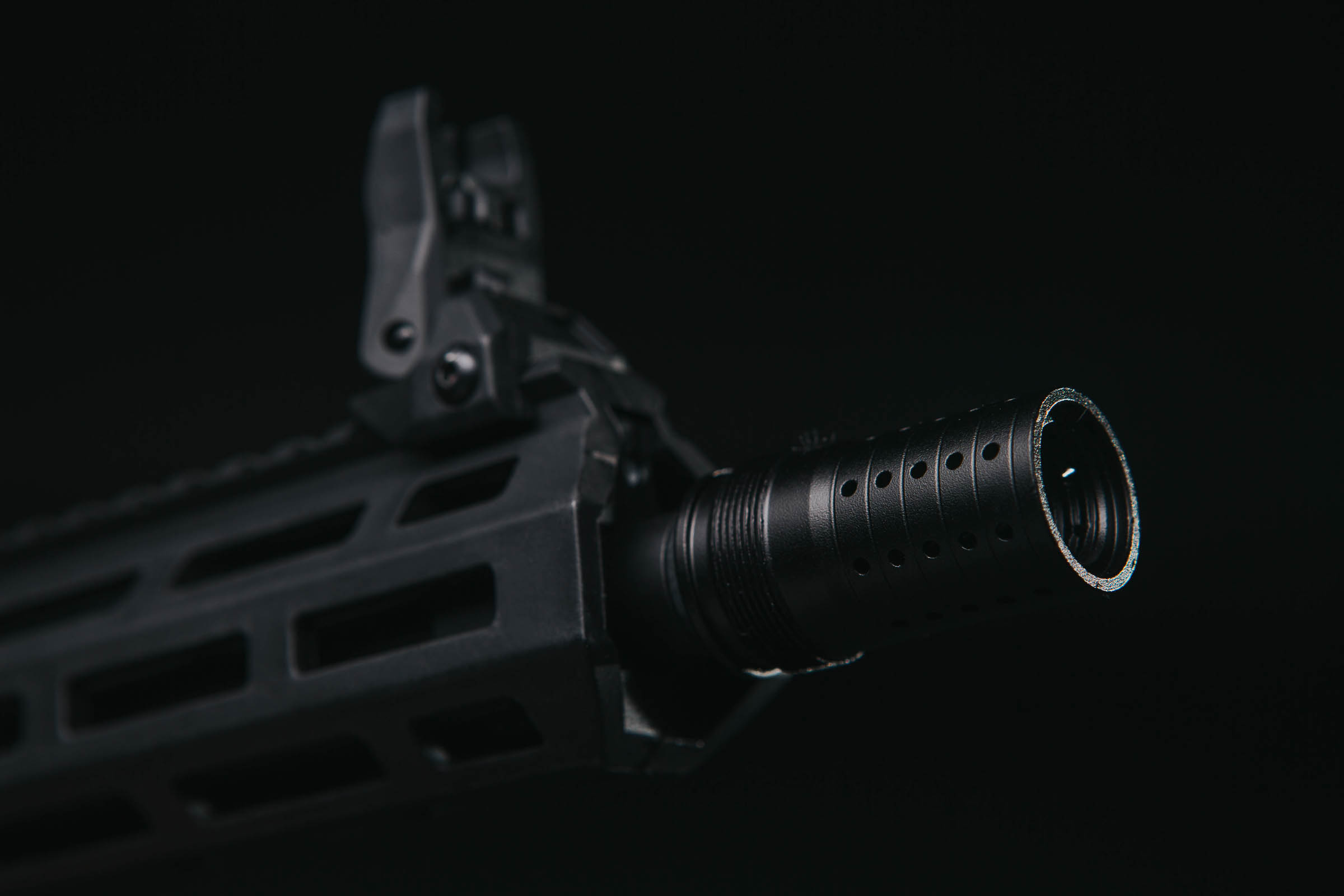
The replica's receiver is a variation on the subject of modern ARs milled receivers. There are 2 things to note here. First, side undercuts in the upper receiver, where the stock guides move. The second is the seemingly enlarged magwell. In practice, however, it turns out that this magwel is only a dummy. Of course, its outer walls are formed into a widening funnel, which is to facilitate changing the magazine, but the inner walls are standard vertical ones. The integrated trigger guard is enlarged and it cannot be detached.
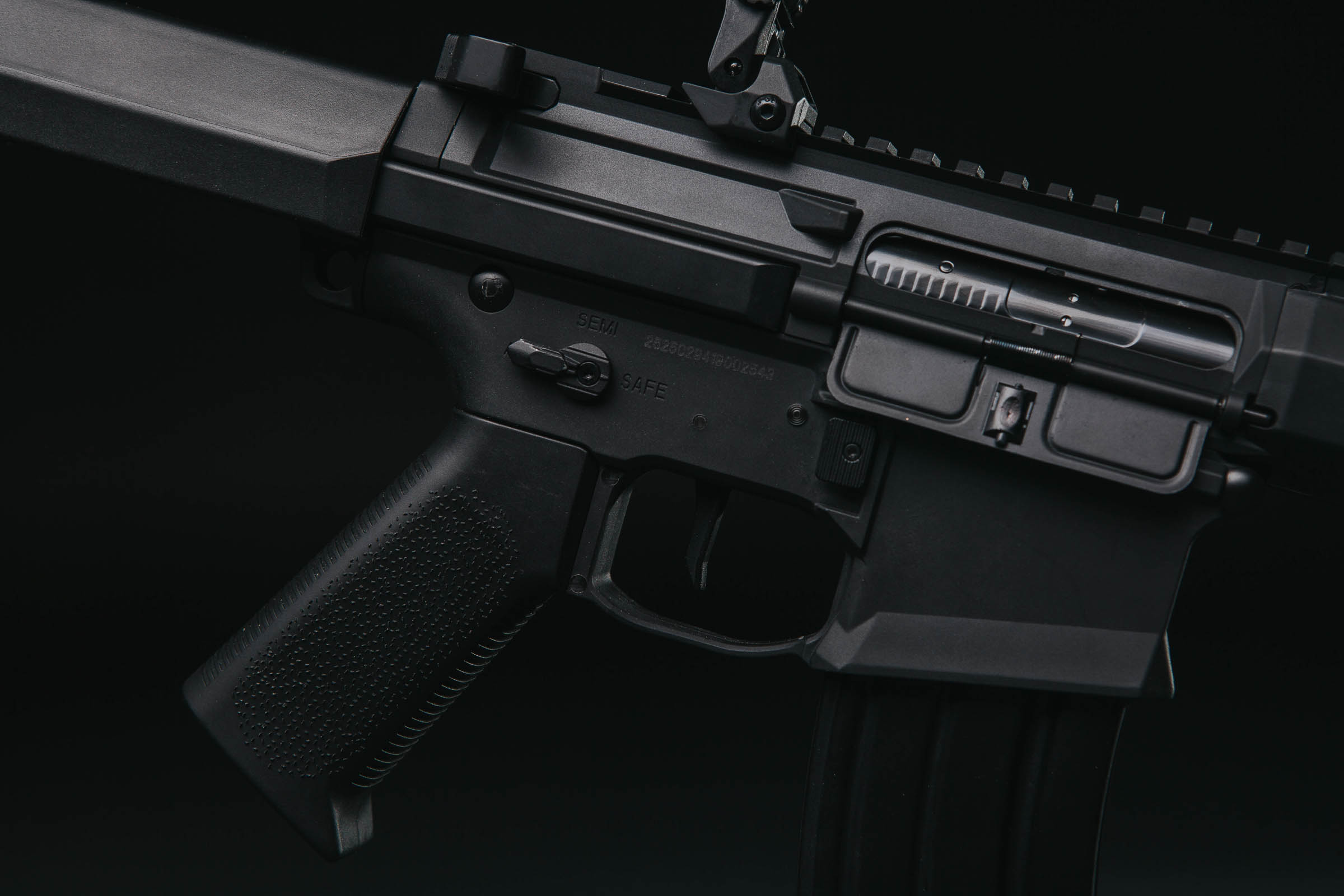
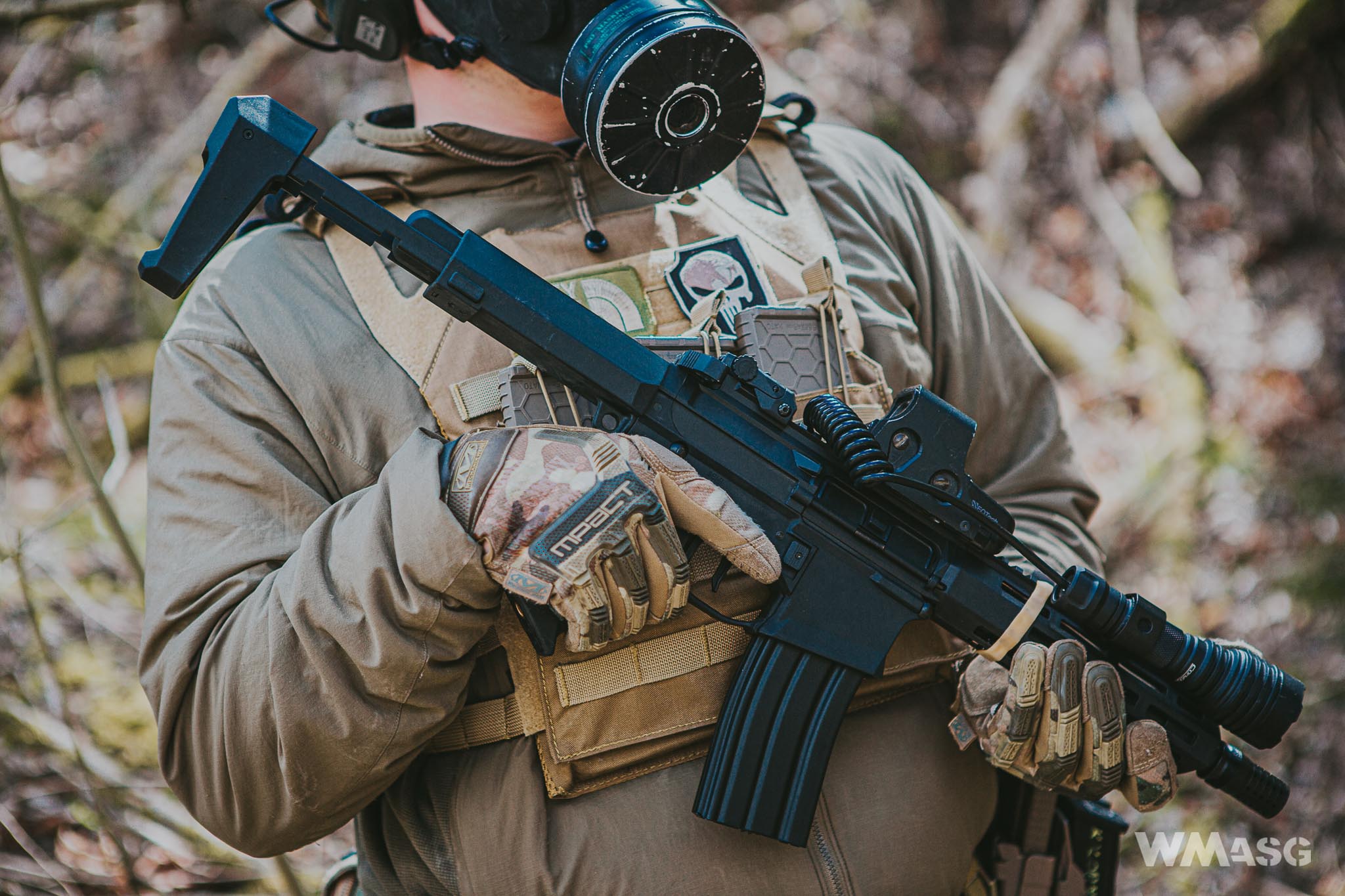
The safety/selector switches are located on both sides. They "click" clearly when set to individual settings and do not show a tendency to switch by themselves. They work with a bit of noise. If I were to have my own copy of the Honey Badger, I would lubricate the gears connecting the right and left switch.
The charging handle is enlarged and looks a bit like high-performance handles with double-sided release levers, but this is just a stylistic choice. In fact, the enlarged latches, except for their appearance, do not serve any purpose, and the release lever is standard and placed in a typical way, on the left side.
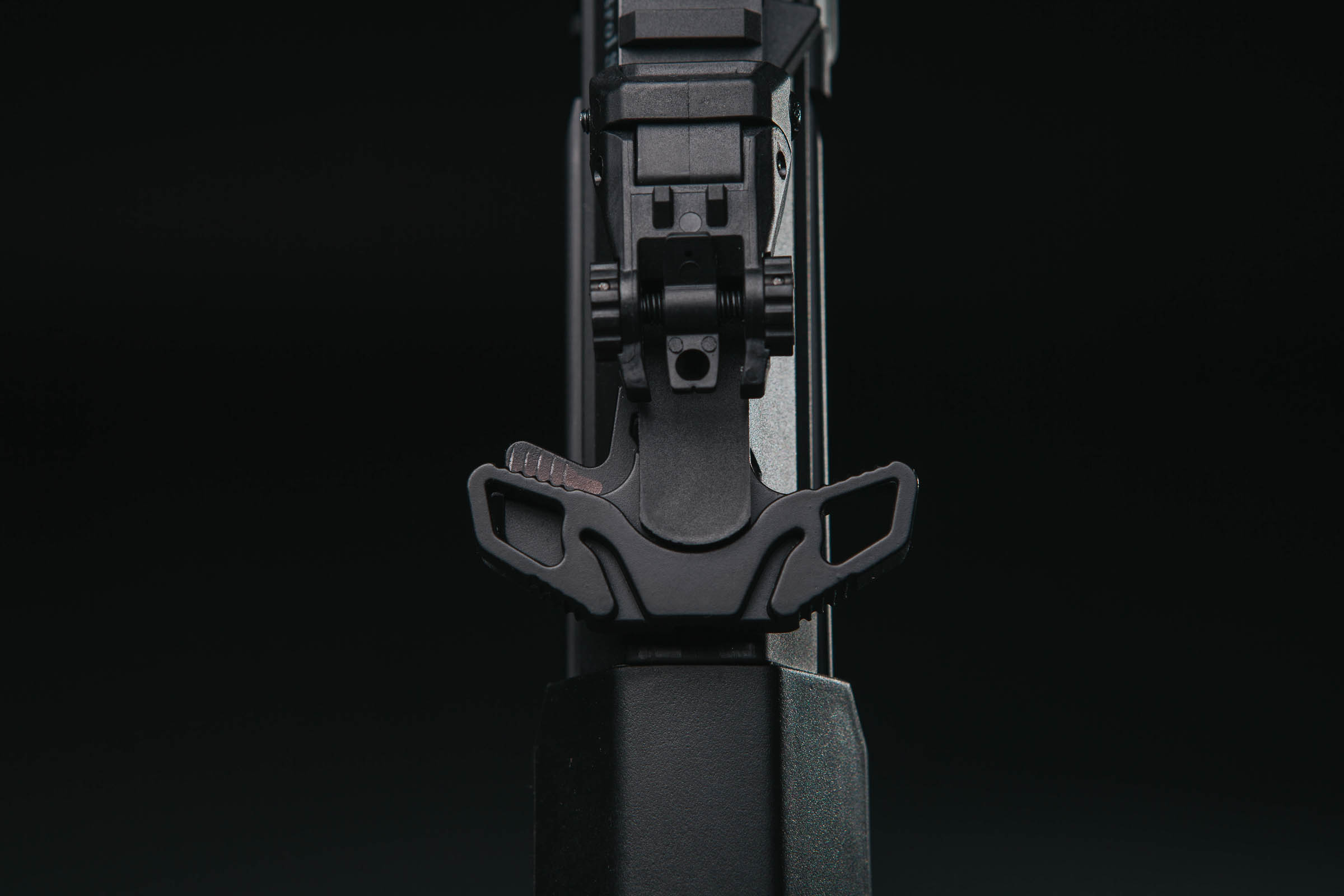
Pulling the handle opens the ejection port and retracts the dummy bolt carrier revealing access to the HopUp adjustment. Unfortunately, the replica does not have the ability to lock the dummy bolt carrier in the rear position therefore, when adjusting the HU, the charging handle must be pulled back constantly. The HopUp chamber has a knob perpendicular to the barrel axis (rotary type) and allows for precise adjustment.
A dummy bolt catch looks standard and luckily sits still and doesn't make any sounds.
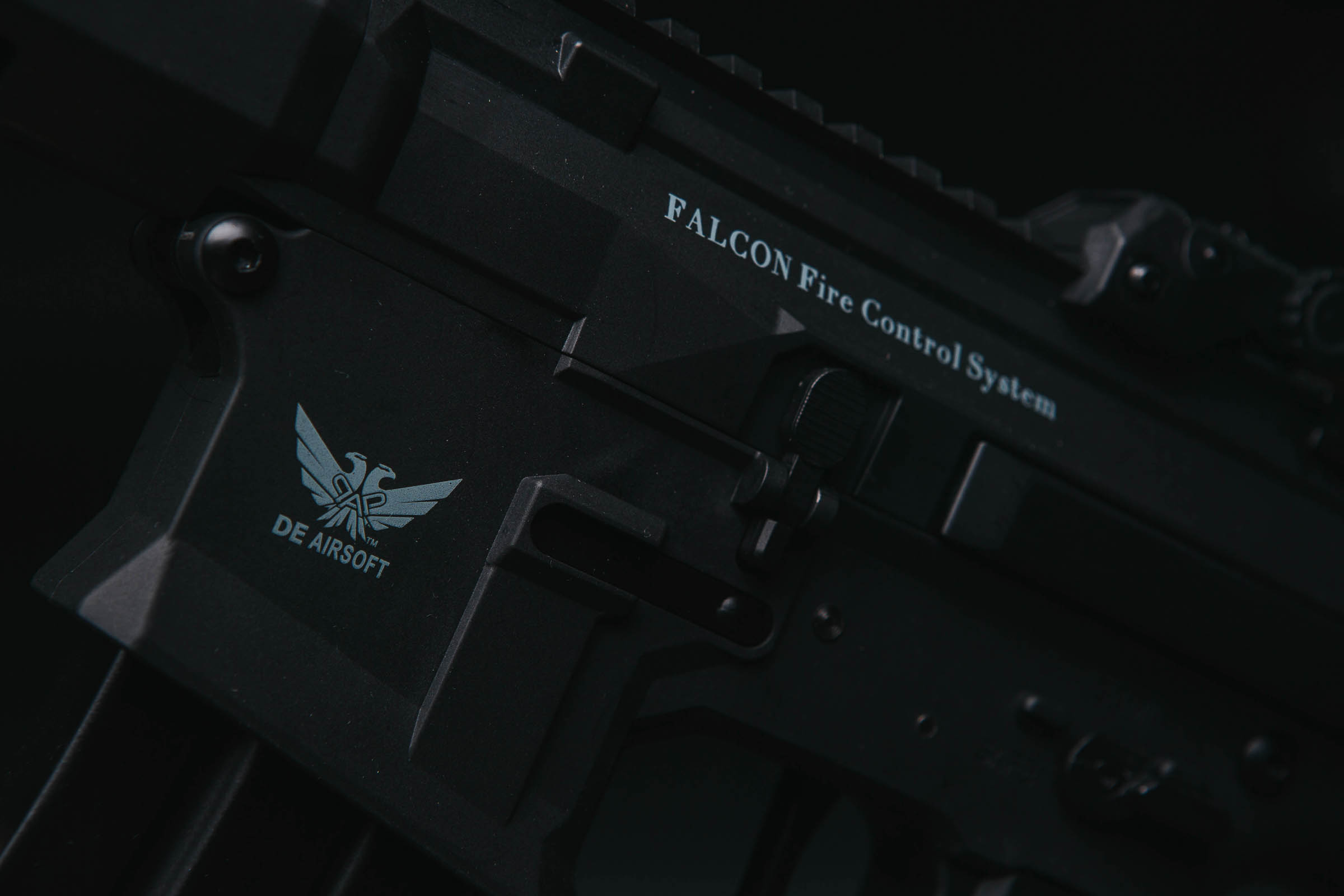
The traditionally built magazine latch has a clearly enlarged button that is slightly protruding from the lower receiver. The index finger finds it every time, but in our opinion the spring of the latch should be a little harder.
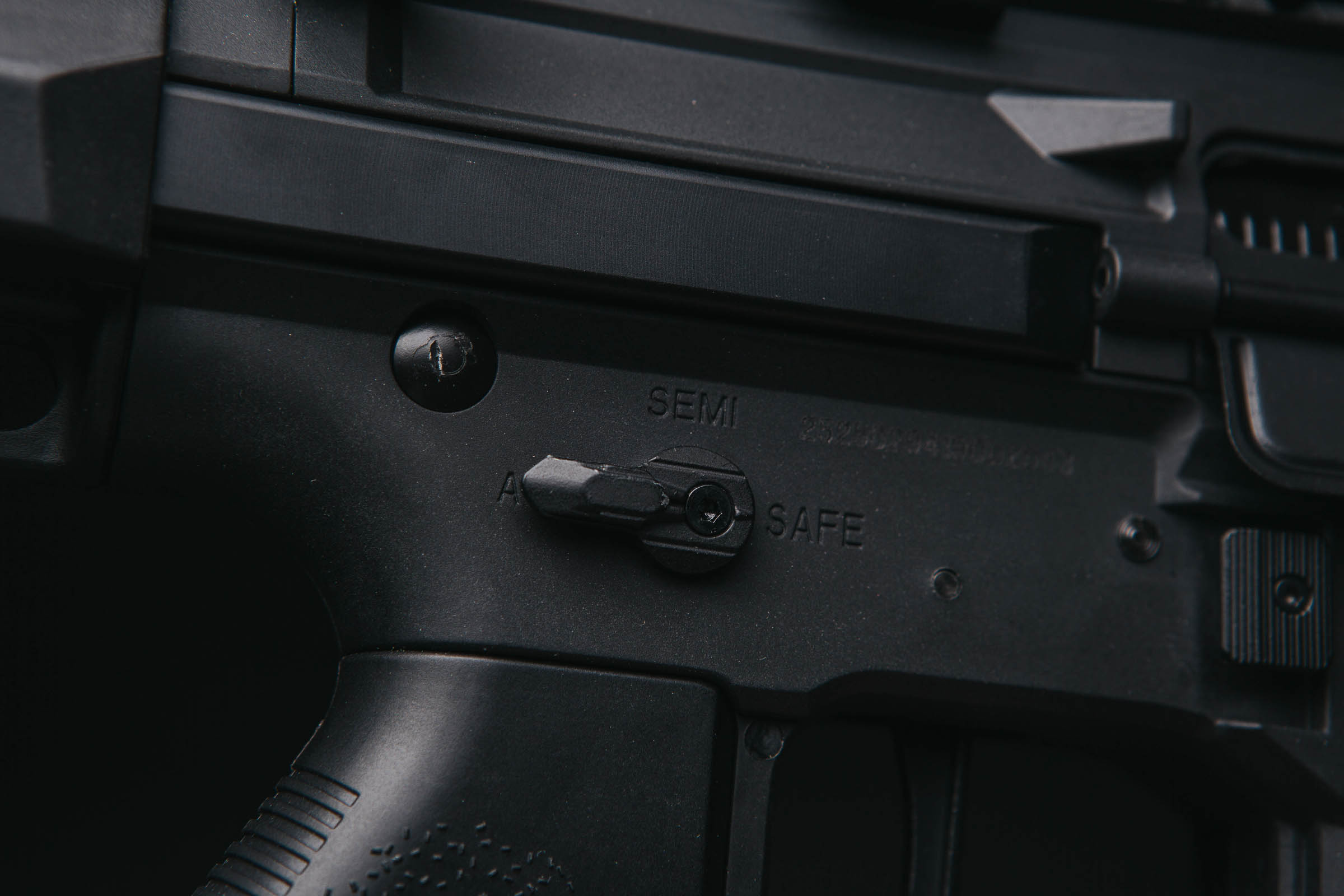
The pistol grip has no additional finger support. Both its front and read surfaces are grooved, and the side surfaces are covered with something similar to stippling but texture is given in during the injection process, and not during subsequent stages of production. The bottom plate is made of metal (ZnAl) and has a large screw to adjust the position of the motor with a head for a flat screwdriver.
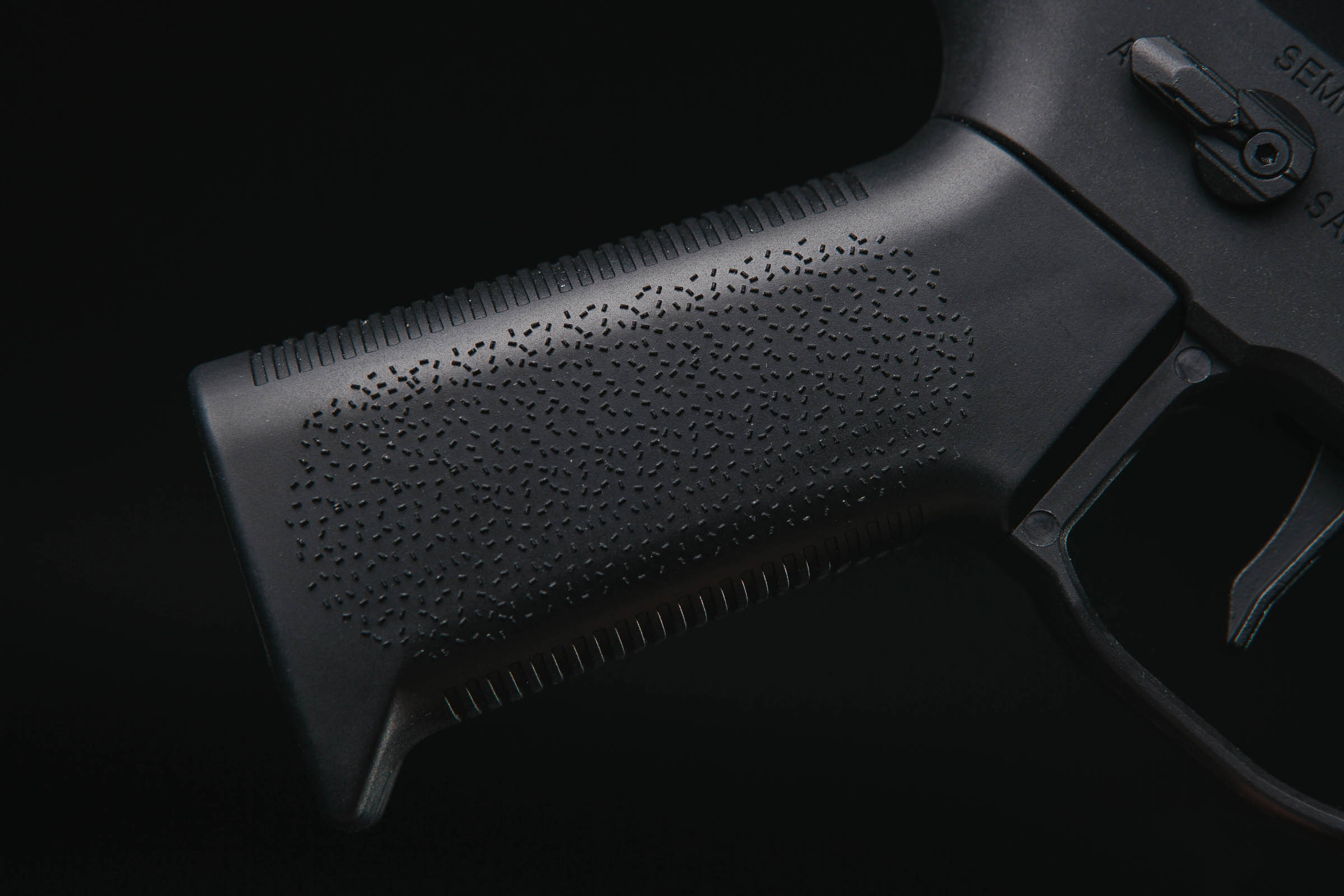
The PDW style stock has 3 length settings. The adjustment buttons are on the sides and must press both at the same time.
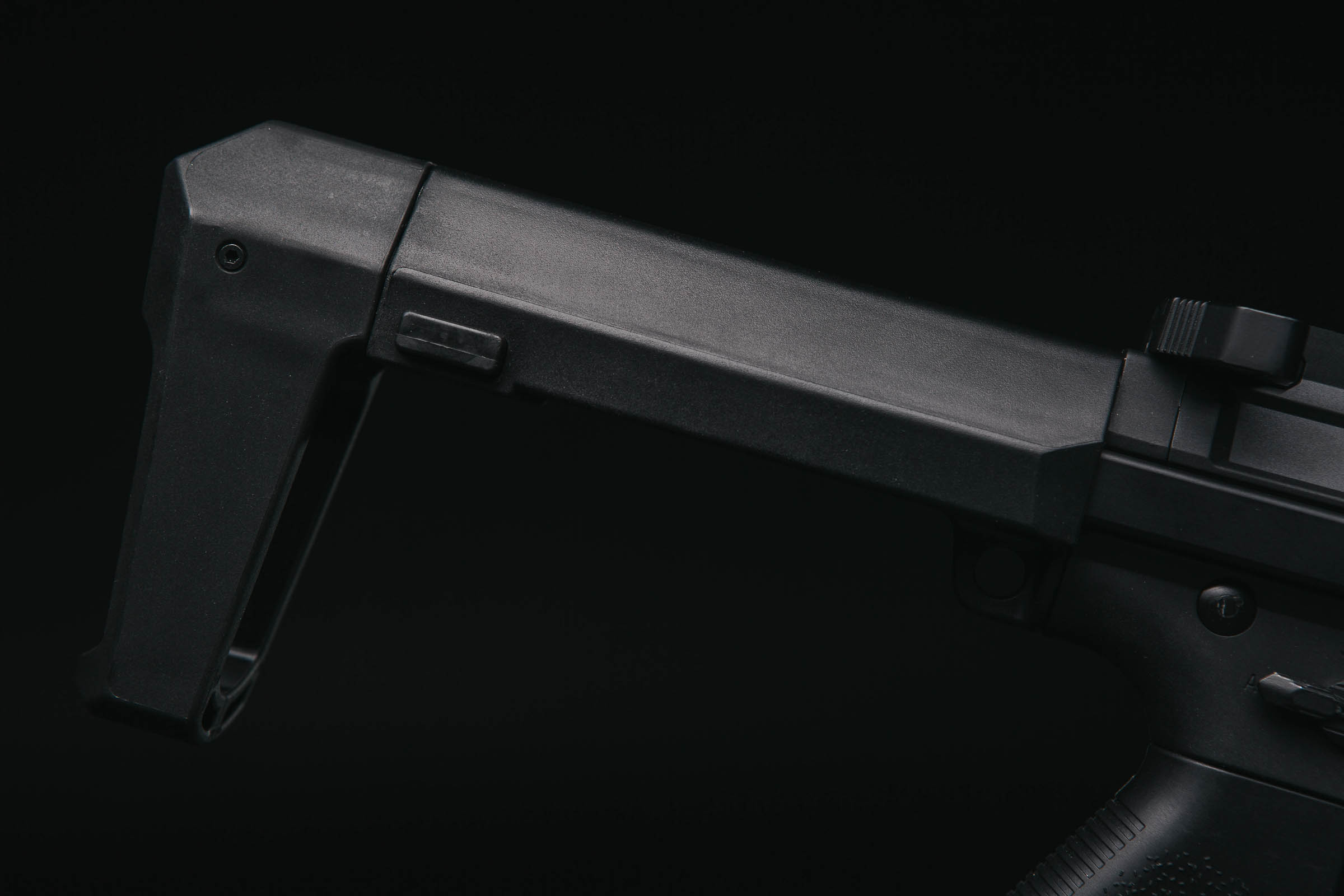
Two side guides move on both sides of the upper receiver.
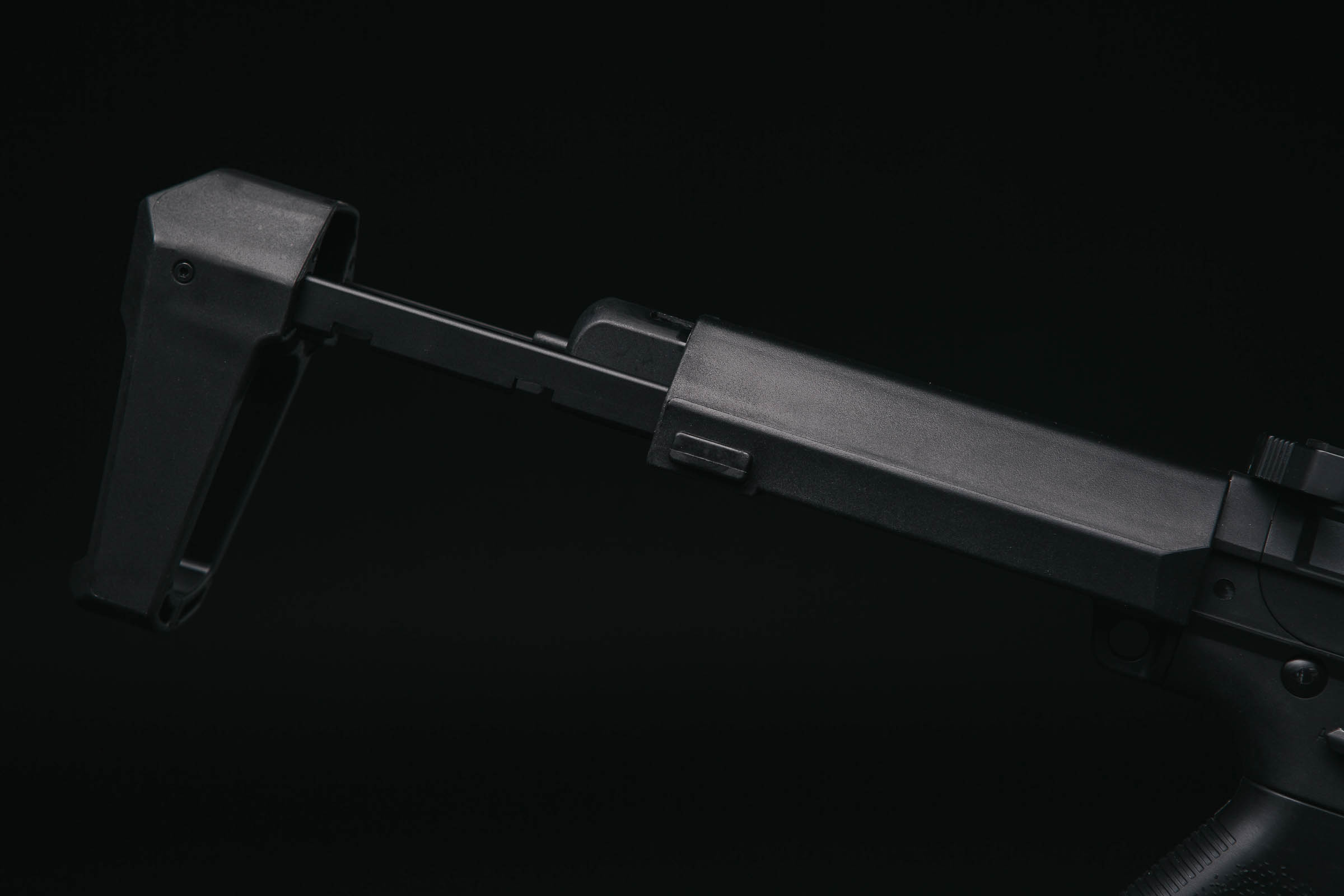
The buffer tube, which has a compartment for the battery, has a trapezoidal cross-section and is clearly widened, but an 11.1V 1800mAh battery with a 2x3 cm cross-section could not fit inside. The space for the battery is 12 cm long. The tube is closed with a plastic plate with a mechanism that initially extends the stock. Interestingly, the mechanism is not a dummy, as one would expect in this class of replicas. Each press of the side buttons, when the stock is completely collapsed, extends it by about 3 centimetres. It's really cool. In the front of the tube, from the bottom, there is an eyelet for mounting the carrying sling. Unfortunately, contrary to its appearance, this is not a QD socket. One has to make, for example, loops out of paracord or hook the sling directly with its own carabiner. The whole stock is made of the same hard nylon from which the receiver and the replica's handguard are made. The only metal parts are side guides.
During our tests, we found out that, due to the loose way of routing the power wires, it is best to install and connect the battery when the stock is extended, but not disconnected from the replica. Otherwise it is possible to damage the wires with one of the guides.
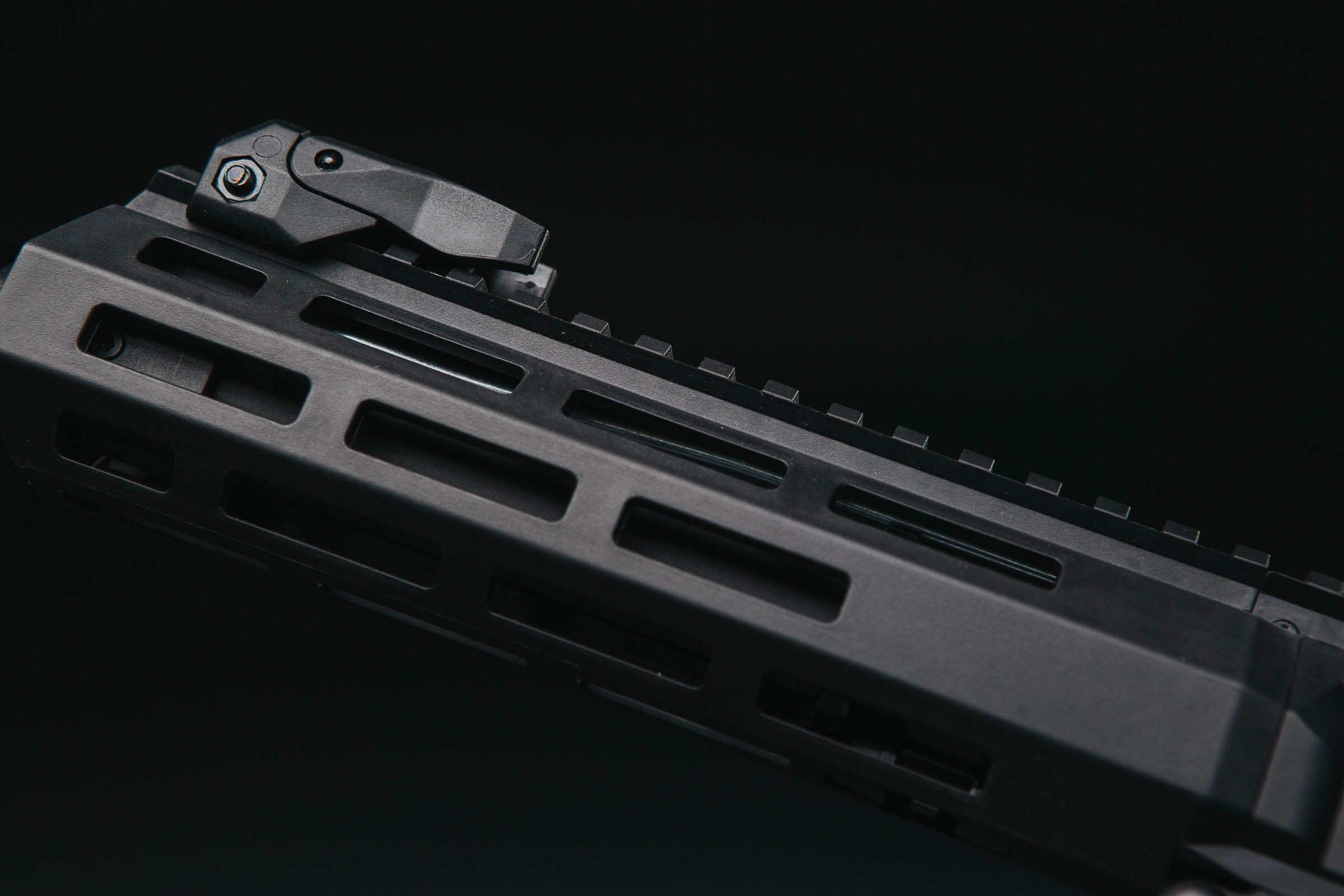
The Honey Badger is equipped with detachable and folding nylon sights. The front sight can be adjusted vertically and the rear sight horizontally. The rear sight aperture has two standard settings - the "night" one with a large opening and the precise one with a smaller hole. Both sights are lifted and folded by hand and have no slack in both positions.

In addition, they were designed as low-profile sights, i.e. can also be used in the folded position, thanks to a second and post up front and a notch in the back. Unfortunately, in practice they turns out to be impossible to use as the "precise" part of the rear sight obscures the low-profile rear sight. There are some chances to modify this, but only at the expense of the rear sight aperture.
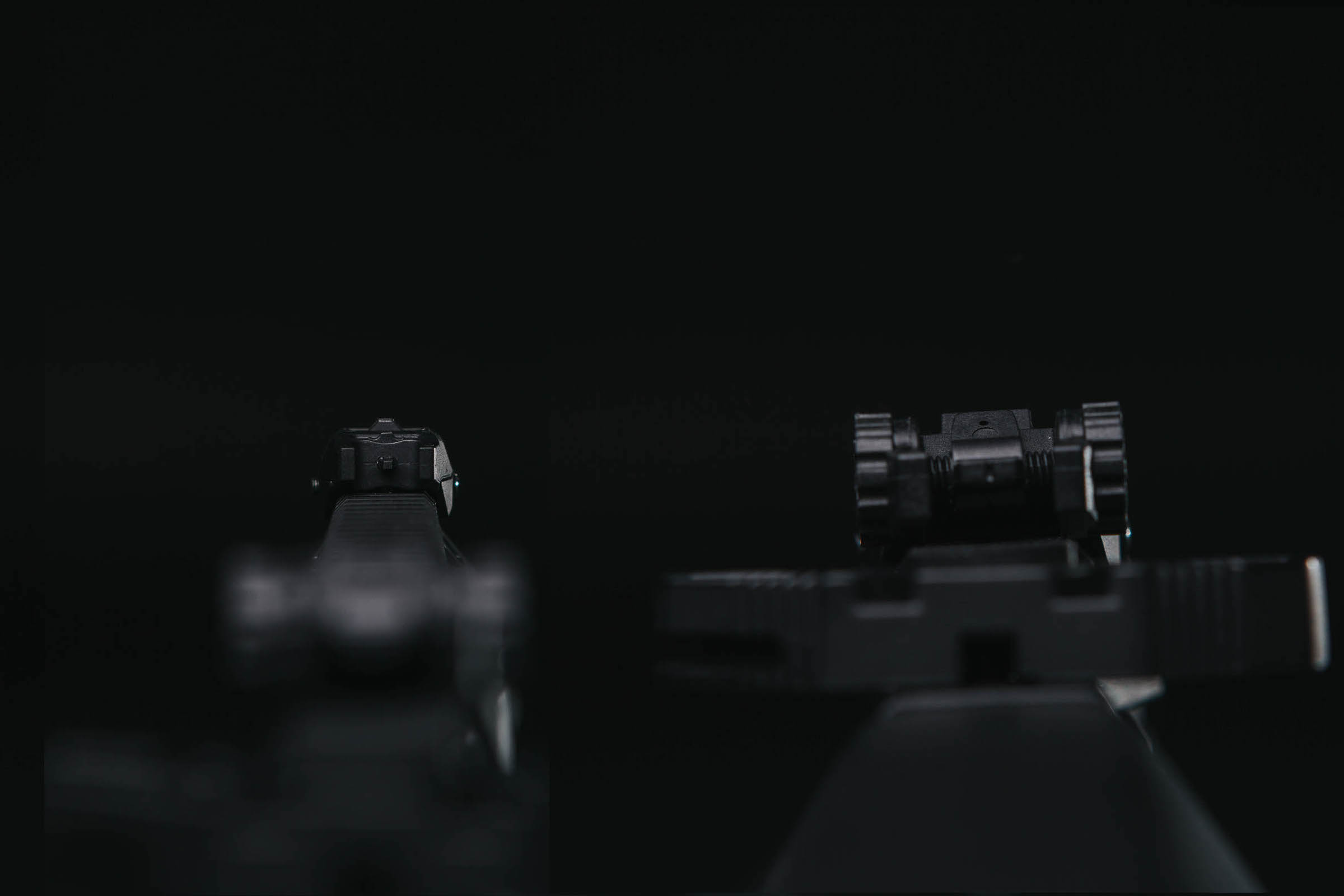
All M90X replicas are driven by the same mechanism based on a standard V2 gearbox with a quick spring change system that can be done from the outside, without opening the replica. However, it is necessary to disassemble the stock and the buffer tube.
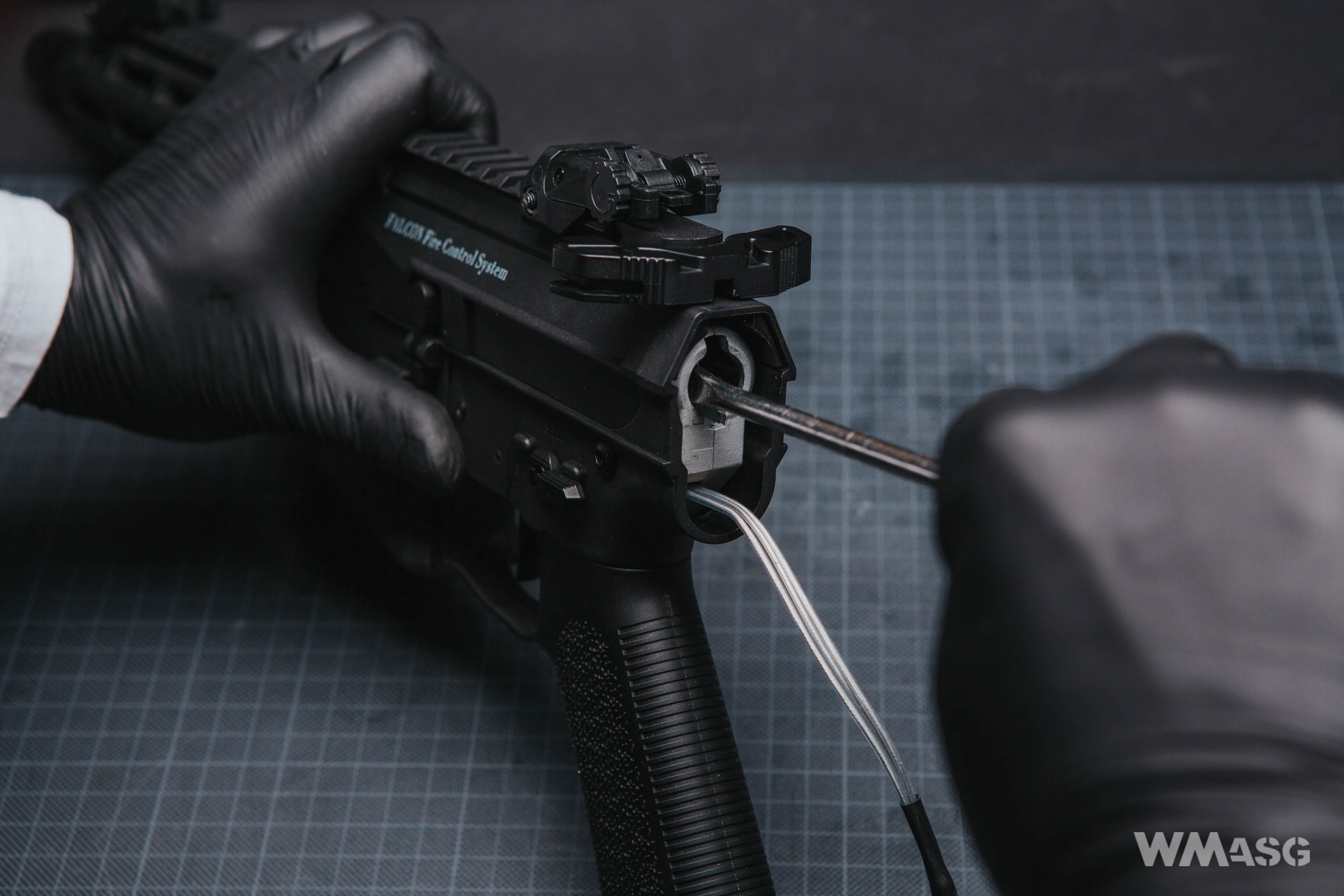
Inside
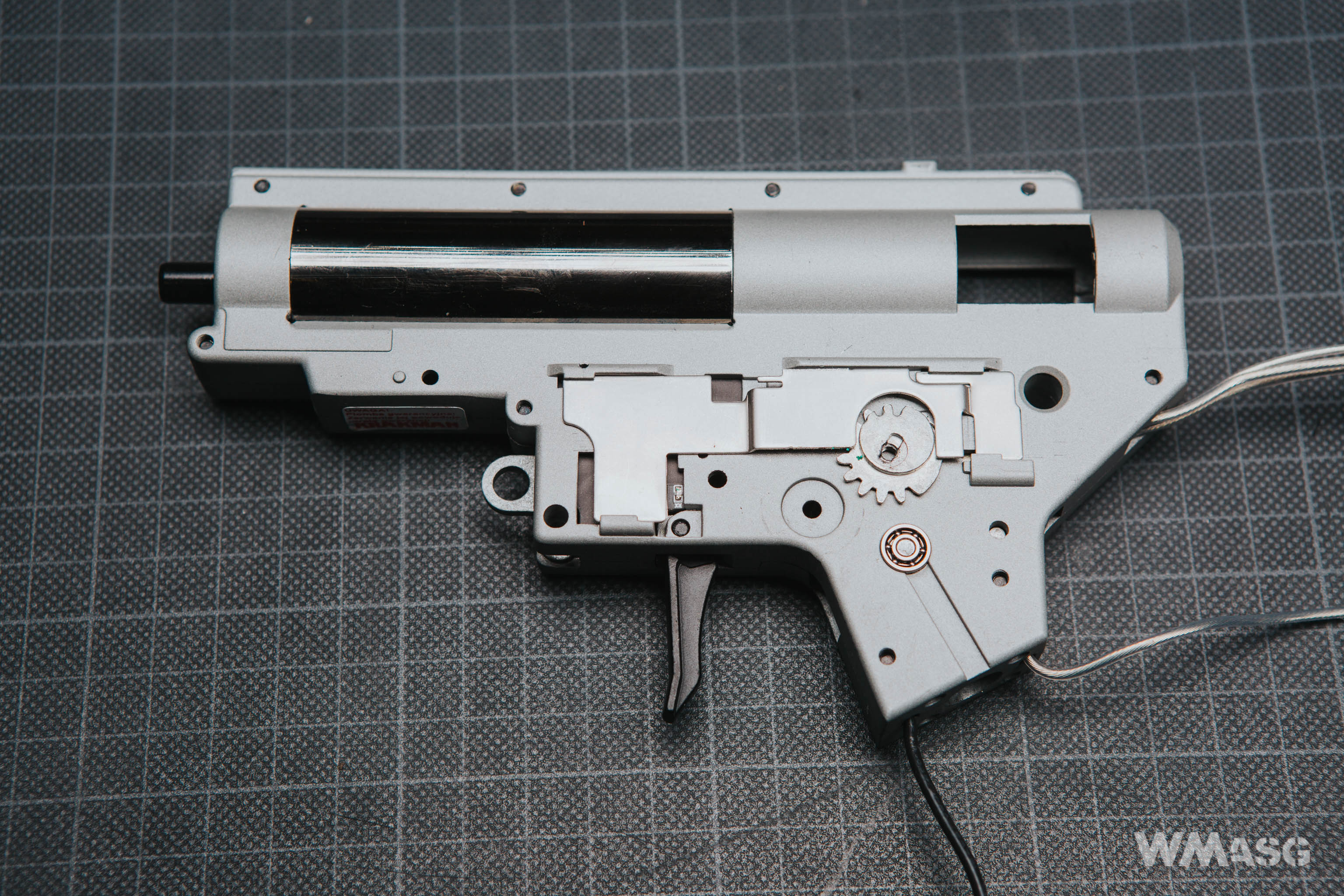
The operation of the mechanism is controlled by the aforementioned Falcon programmable system, with which you can choose between SEMI/AUTO and SEMI/BURST firing modes while setting the length of the BURST mode from 1 to 5 shots. When we set BURST to 1, the replica will fire with single BB in both selector settings (SEMI/BURST), unless we also turn on the double-shot mode, then in the SEMI position with shoot 2 BBs in each cycle: the first one when pressing the trigger, the second one when releasing the trigger, and in the BURST position it will shoot only one BB.
The third adjustable parameter in the Falcon is the trigger pull with 3 settings: standard, short and very short. In combination with a vertical "quick" trigger it works really well.
The system is programmed with successive trigger pulls and each setting is confirmed with the safety/selector switch. Detailed instructions are attached to the replica and at the Taiwangun website there is also a short instructional video showing exactly how to do it.

In addition to the features described above, Falcon has several other functions. First, it tracks the operation of the sector gear (cycle control) and always stops the mechanism with the piston in the front position. And besides that, it is also a mosfet and an advanced voltage cut-off fuse when something bad happens with the replica or the battery.
The design of the system itself is obviously nothing revolutionary and replicates the already known solutions, but it is worth noting that the Falcon system has no mechanical parts as the position of the sector gear and the movement of the trigger and the selector plate are monitored by optical sensors. And while testing it with a flashlight from different angles, we were unable to activate the system without pressing the trigger, which, unfortunately, happens to the products of some other manufacturers.
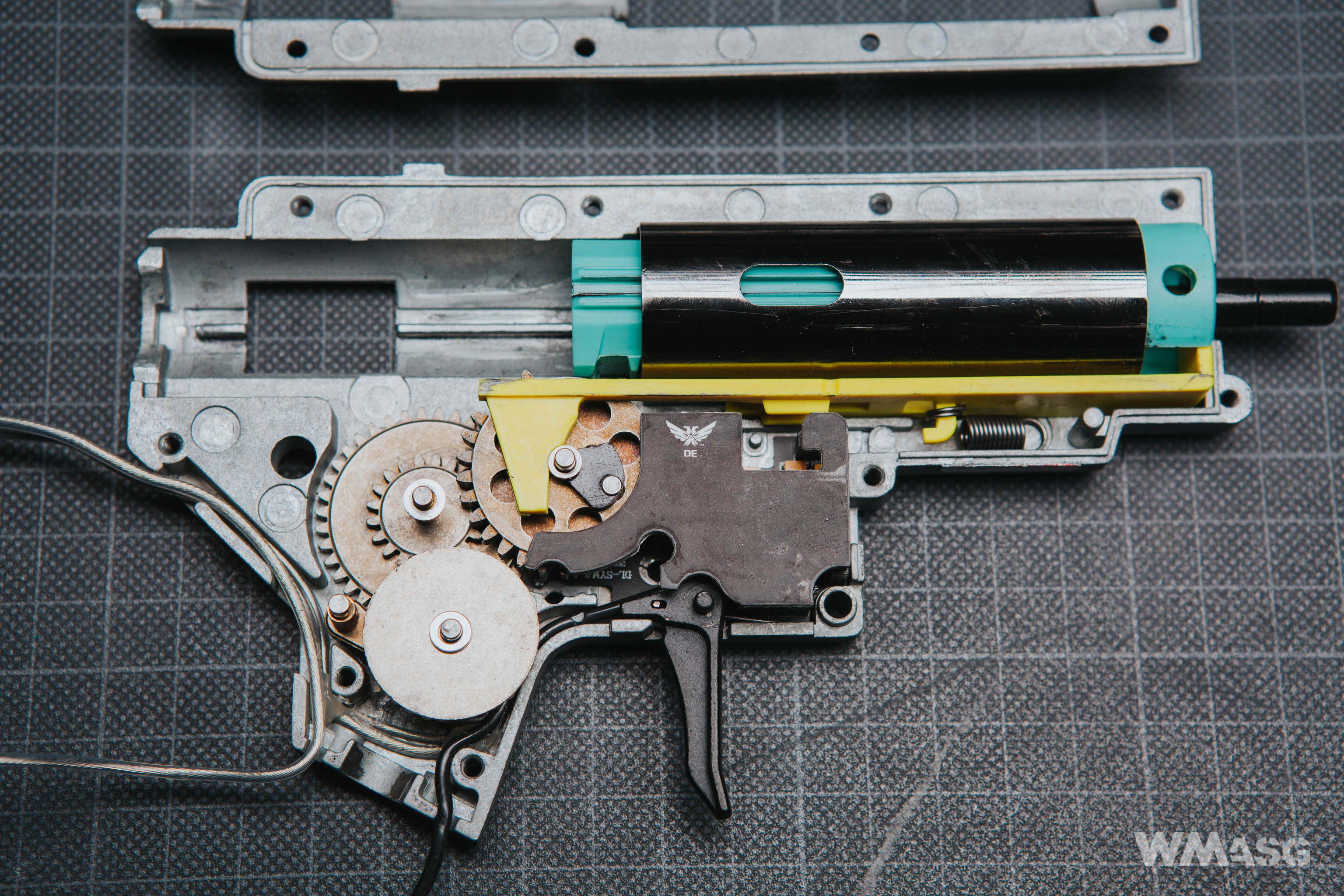
On the mechanical side, the gearbox is typical for mid-price range replicas. Of the reinforced parts, we only have a ball bearing piston head and a ball bearing spring guide. The piston has three steel teeth and is made of the same material as the cylinder head and is also equipped with a solid bumper. The gears are set in 9 mm bearings are made of sintered steel. The bevel gear is set in ball bearings, other wheels are set in plain bearings. The nozzle has no o-ring. Low resistance wires and a factory-fitted DEANS plug deserve praise (hence the presence of a battery adapter with a small Tamiya plug included). Assembly and fitting of parts is at an average level. The gears' shimming could be slightly improved and the lubrication of the gears and the cylinder system could be slightly better, but this is common in replicas from this price range.
The whole mechanism look identical the one used in the Poseidon branded replica of the Punisher series:
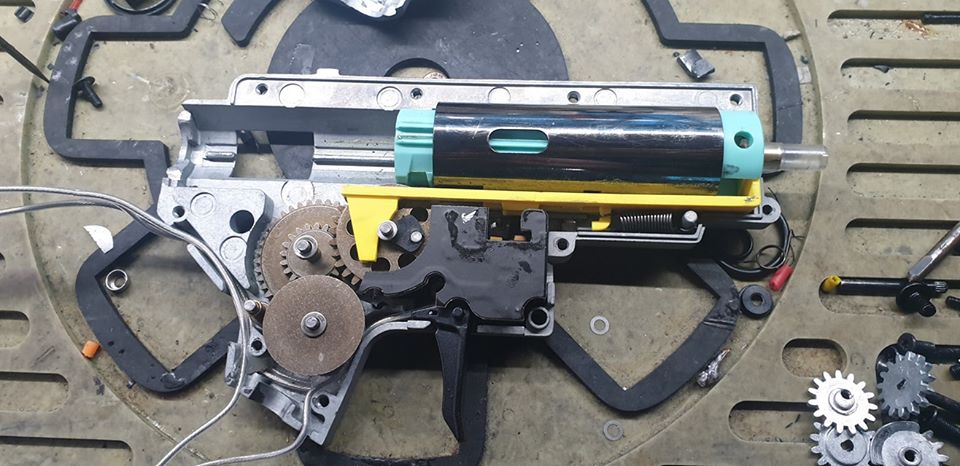
Muzzle velocity test and target shooting test
Muzzle velocity
Open Blaster 0.2 g BBs, XCORTECH X3500 chronograph
- 361.4
- 361.4
- 388.7
- 390.5
- 381.9
- 379.4
- 372.2
- 363.6
- 375.4
- 362.6
Average: 373.7 fps – which is in accordance with the manufacturer declarations (370 fps)
Rate of fire (using a 11.1V 1800mAh 45C battery): 14.5 rps
Targer shooting test
The test was done in field conditions. The temperature was around 14°C. There was no wind. Distance to target was 25 meters. G&G BBs 0.25 g were used.
Single fire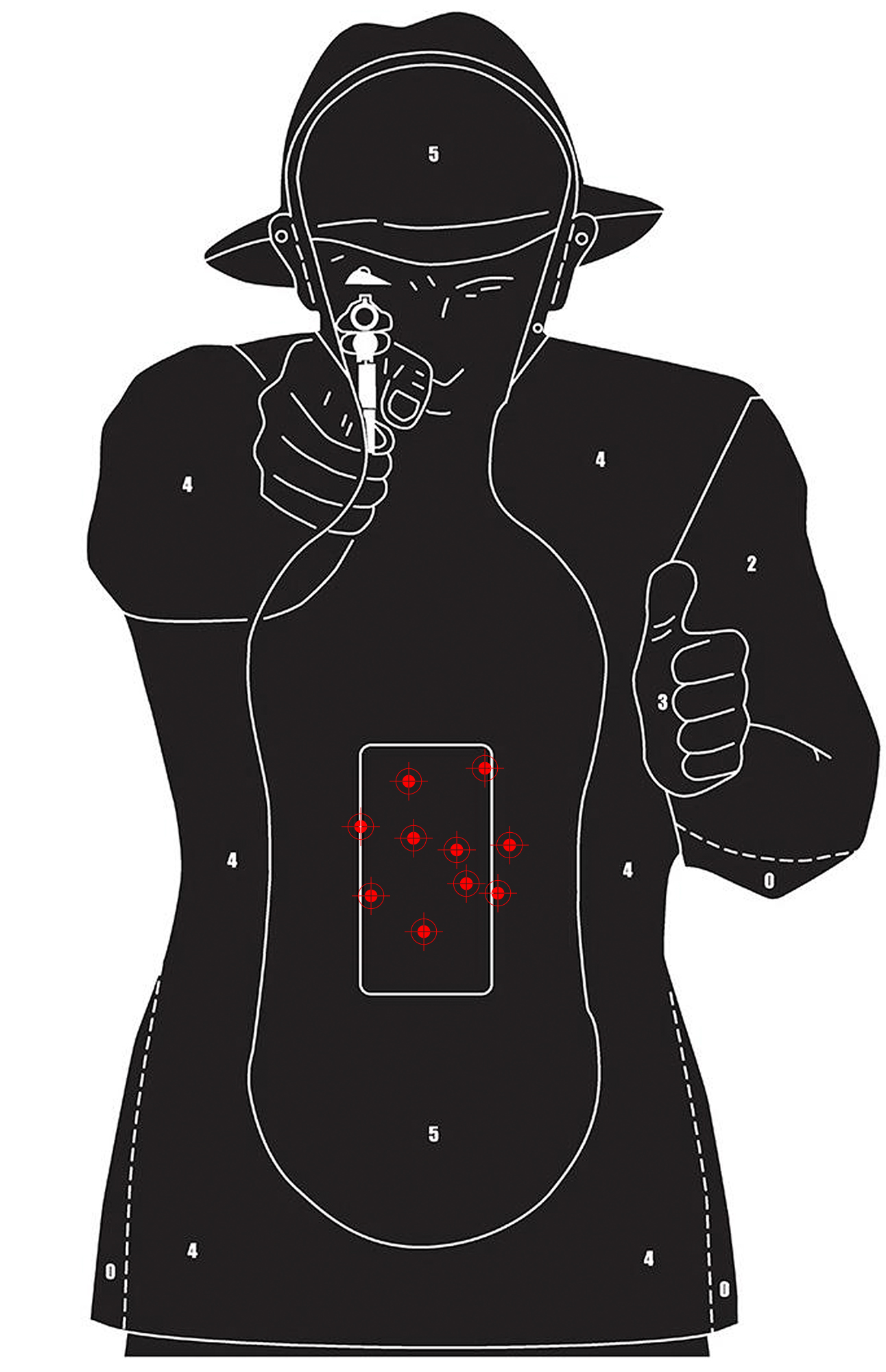
Full-auto
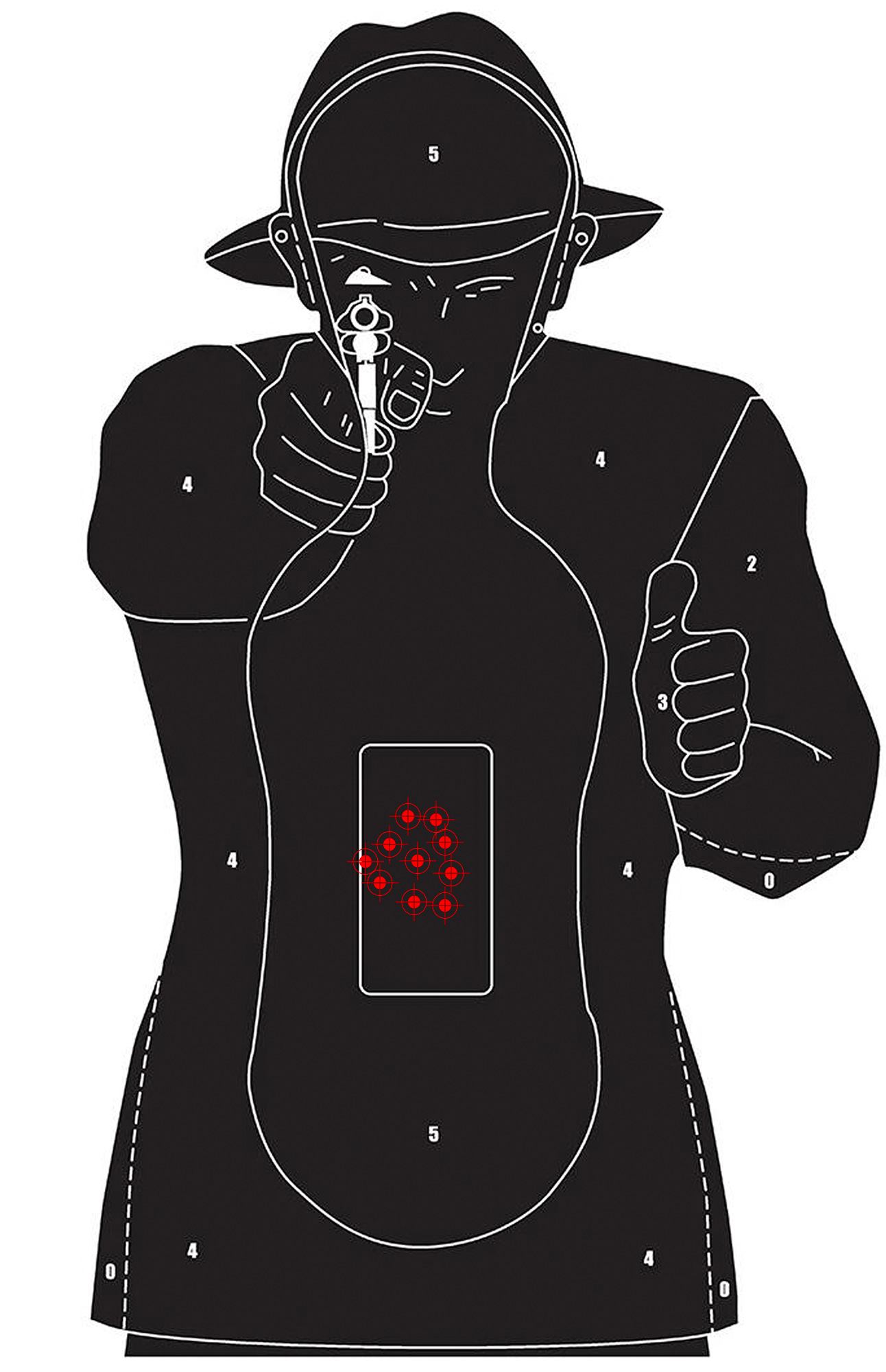
BB holes with a maximum spread of 3 cm.
The total range using 0.25 g BBs and with the HopUp system adjusted was about 50 meters (flat trajectory of the BBs, without them rising up at the end of the flight path).
Summary
In our opinion, the compact nylon M904G turns out to be surprisingly good. Of course, for many people, the material from which it is made will be a disqualifying disadvantage. But if someone is looking for an extremely handy replica for dynamic games and maneuverability is the deciding factor, why not? There is a lot of tuning potential and an electronic quick trigger with the possibility of programming, combined with a really small weight and dimensions make it an interesting choice. Subjectively, the replica seems to be even more handy than the one we tested recently, the ICS PDW9 pistol caliber carbine. And if someone has to have a "full metal" replica, there is the almost identical M907E model to the one we described here (it differs only in the stock used), which has a ZnAl receiver and an aluminum handguard.
In turn, for people who are just starting playing, for whom price is the basic argument, the M904G should also be interesting choice. Around 115 EUR for a well made replica with a programmable trigger? With the above shown results during the target shooting test?
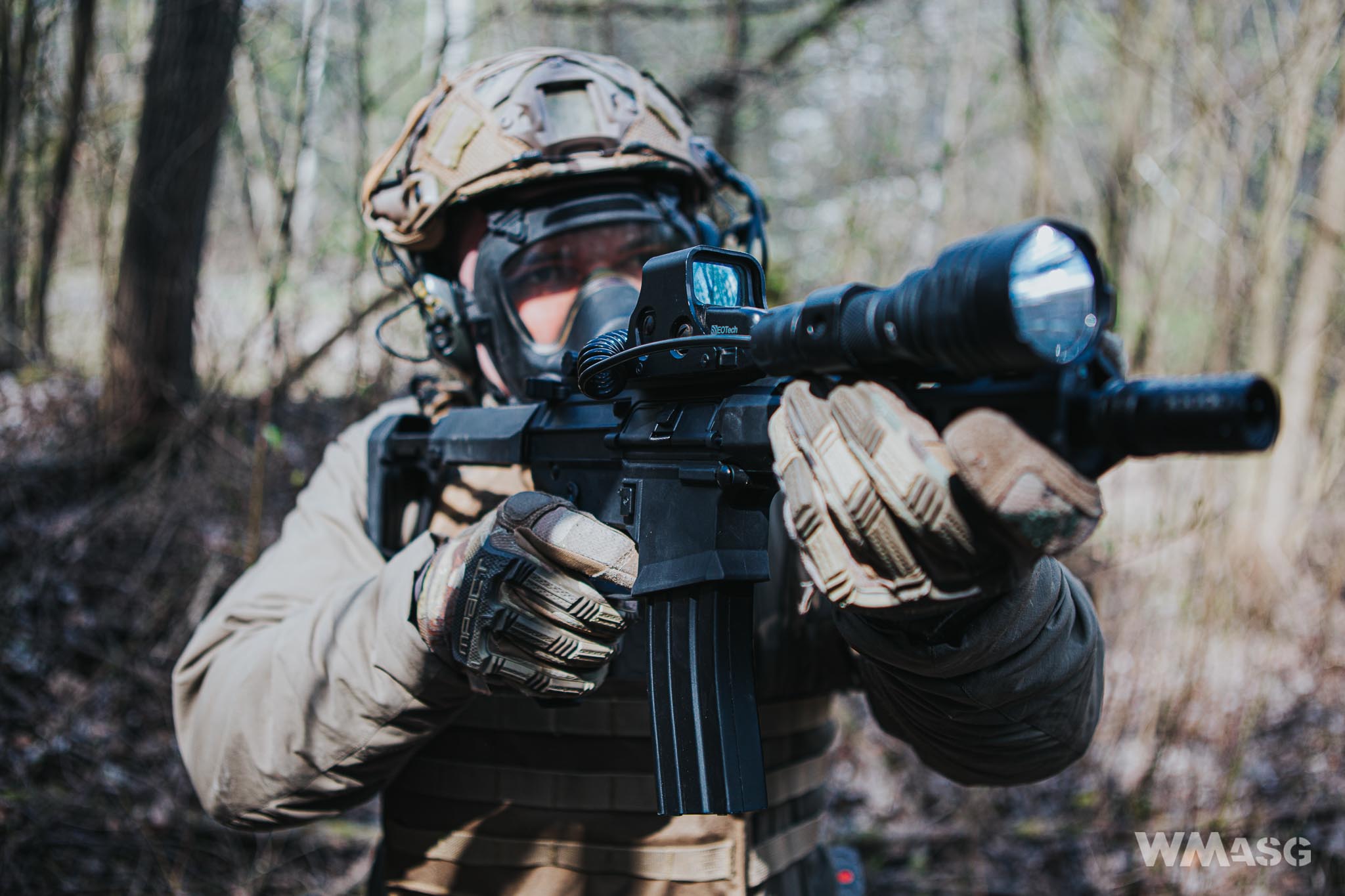
On the next page - technical details



